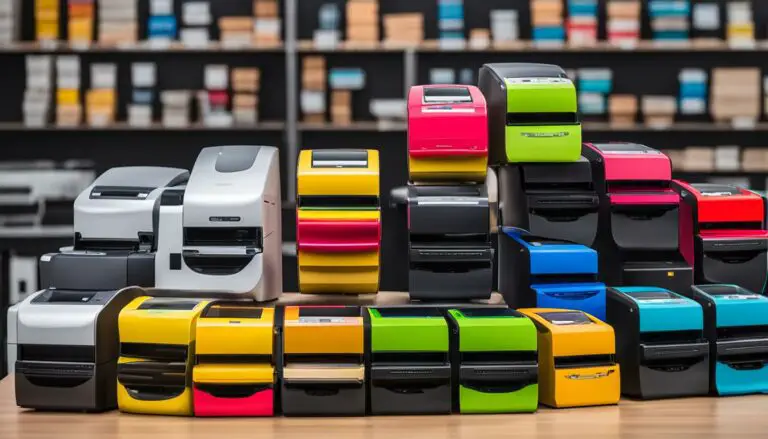Can You Use Regular Printer Paper for Sublimation? Unleash the Surprising Magic
Originally posted on August 23, 2023 @ 8:42 am
Dear reader, welcome to our thorough guide to answering the question, “Can You Use Regular Printer Paper for Sublimation?” If you are interested in exploring the realm of sublimation projects and are curious about the capabilities of regular printer paper, you have found the perfect resource.
In this article, we discuss the science behind sublimation methodology, explore the characteristics of both regular printer paper and specialized sublimation paper, and provide practical insights into maximizing your printing quality and longevity. Whether you’re a hobbyist or a professional, join us in uncovering the secrets to achieving remarkable sublimation prints.
Can You Use Regular Printer Paper for Sublimation? (The Quick Answer)
No, using regular printer paper won’t yield desired results. Sublimation requires specialized paper to transfer dyes effectively onto substrates. Regular paper can’t withstand the high heat and won’t produce vibrant, durable prints. Opt for a dedicated dye sublimation printer paper for the best outcomes.
What Can You Use Instead of Sublimation Paper?
When sublimation paper is unavailable, alternatives like heat-resistant copy paper or parchment paper can be utilized, but results may vary. Heat-resistant copy paper can withstand the sublimation process to some extent, producing acceptable results for certain projects. Parchment paper, though not as effective, could work for light-colored fabrics.
However, it’s important to acknowledge that dedicated sublimation paper is designed to provide consistent, vibrant, and durable outcomes due to its specialized coating. While alternatives might be suitable for occasional use, investing in proper sublimation paper remains the optimal choice for achieving the best quality and longevity in sublimation projects.
What Is the Difference Between Sublimation Paper and Regular Copy Paper?
Sublimation paper and standard copy paper differ significantly in their composition and purpose. Sublimation paper features a specialized coating that absorbs the inks, ensuring vibrant colors and optimal transfer onto various substrates under high heat print.
In contrast, copy paper lacks this coating, leading to print ink dispersion and dull colors during sublimation. The coating on sublimation paper also prevents paper fibers from melting, maintaining print clarity. Regular copy paper, designed for everyday letter press, cannot withstand the heat required for sublimation and fails to deliver the longevity and quality essential for sublimation projects.
What Can You Use Besides Butcher Paper for Sublimation?
In place of butcher paper, silicone-coated parchment paper is a viable option for heat presses for the sublimation transfer paper. It is heat resistance and its non-stick properties make it suitable for protecting the heat press and preventing ink transfer onto the press’s surfaces.
However, unlike butcher paper, silicone parchment paper may not provide the same level of breathability and even heat distribution. It’s advisable to use dedicated butcher paper or silicone-coated parchment paper designed for sublimation to achieve optimal results. These materials facilitate transfer of dye sublimation ink while protecting both the substrate and heat press during the process.
Also Read: DTF vs. Sublimation
What Do You Do With Sublimation Paper?
Sublimation paper is used to transfer vibrant designs from sublimation ink onto various substrates like fabrics, ceramics, and metals. The paper’s specialized coating absorbs the ink, and under high heat and pressure, the ink sublimates—turning directly from solid to gas—embedding the design permanently onto the substrate’s surface. This process yields durable, high-quality prints suitable for a wide range of personalized items and promotional materials.
Does Sublimation Paper Matter? What Kind of Paper Is Sublimation Paper?
Sublimation paper is a specially coated type of paper designed for use in sublimation projects. It has a unique surface coating that enables it to absorb inks and release them evenly onto various substrates when exposed to high heat and pressure. This coating ensures vibrant colors, sharp details, and durable results, making sublimation paper an essential component for achieving high-quality prints in sublimation project applications.
Sublimation paper is crucial for successful sublimation projects. It possesses a specialized coating that absorbs the inks and releases them uniformly during the heating process. This coating prevents ink dispersion, resulting in vibrant, precise, and long-lasting prints on various substrates like fabrics, ceramics, and metals.
Regular paper lacks this coating, leading to dull colors, more ink bleeding, and reduced durability. Sublimation paper’s unique qualities ensure optimal transfer of dye sublimation ink, color accuracy, and resistance to heat-induced degradation, making it an indispensable element for achieving high-quality, professional results in sublimation printing projects.
Is Sublimation Paper the Same as Transfer Paper?
Sublimation paper and transfer paper are not the same. Sublimation paper is specifically designed for sublimation printing, featuring a coating that enables proper ink absorption and release during the heat transfer procedure.
Thermal transfer paper, on the other hand, is a more general term that encompasses various types of papers used for transferring images or designs onto different surfaces using different methods, such as heat or pressure. While sublimation print paper is a type of heat transfer paper used, not all heat transfer paper types are suitable for sublimation printing due to their differing coatings and intended applications.
What Is Different About Sublimation Printing Paper?
Sublimation paper stands out due to its specialized coating that facilitates the absorption, even distribution, and controlled release of the inks during the heat transfer procedure. This coating is pivotal in achieving vibrant colors, sharp details, and durable prints on various substrates.
Unlike ordinary paper, sublimation paper can withstand the high temperatures needed for the process without melting or distorting, ensuring consistent, professional-quality results. Its unique properties make it a crucial element for successful printing applications.
Can I Turn My Regular Printer Into a Sublimation Ink Printer?
Converting a a regular ink and printer into a speciality sub printer involves more than just switching paper types. While it’s possible to retrofit certain inkjet printers for sublimation, it’s a complex process. You’ll need to replace inks with sublimation-specific ones, modify the printer’s firmware, and ensure proper temperature control.
Moreover, sublimation requires specialized paper with a special coating, that interacts with sub inks. Without these adjustments, your regular printer won’t deliver accurate colors, longevity, or optimal heat resistance. For consistent, high-quality sublimation printing, it’s recommended to invest in a dedicated sublimation printer that’s designed to handle the specific requirements of the sublimation process.
Is a Laser Printer the Same as a Sublimation Printer?
No, a laser printer is not the same as a sublimation printer. Laser printers use toner to create images on paper using a static charge and heat, while sublimation printers use specialized sub inks to transfer designs onto various substrates through a heat and pressure process.
Sublimation type printers are designed specifically for sublimation printing, allowing for vibrant and permanent color transfer onto materials like fabrics, ceramics, and metals. Laser printers lack the capability to perform sublimation printing due to differences in ink composition and transfer mechanisms.
Can You Use Sublimation Ink on Any Paper?
Sublimation ink is specially formulated for use with sublimation paper, which has a unique coating that facilitates ink absorption and release during the heat transfering process. Using Sublimation ink on ordinary paper won’t yield the desired results due to the lack of this specialized coating.
Standard paper won’t effectively hold or transfer the sublimation ink, leading to poor color vibrancy, bad printed image, bleeding, and reduced durability. To achieve vibrant and long-lasting results, it’s essential to utilize sublimation ink in combination with dedicated sublimation paper or specialty paper, designed to work seamlessly together with the sublimation blanks in the sublimation printing process.
Can You Use Laser Paper in Sublimation Printers?
No, using laser paper in these printers is not recommended. Laser paper is designed for use with laser printers, which utilize toner rather than liquid or regular ink. Sublimation printers, on the other hand, use specialized inks that require a specific type of paper (Sublimation transfer paper) with a coating designed to absorb and release these inks during the thermal transfer printing method.
Attempting to use laser paper in a sublimation type printer will likely result in poor ink absorption, color distortion, and unsatisfactory transfer onto substrates, leading to subpar and inconsistent results.
What Is Printer Copy Paper? What Copy Paper Can You Use for Sublimation?
Printer copy paper, also known simply as printed copy paper, is a type of paper specifically designed for use in printers, copiers, and other imaging devices. It’s typically used for printing text, graphics, and images in both black and white and color. Copy paper comes in various sizes, weights, and qualities to accommodate different printing needs, making it a fundamental element in everyday document and image reproduction.
Using standard copy paper is not recommended, as it lacks the necessary coating to absorb and transfer sublimation inks effectively. For better results, you can opt for thermal -resistant copy paper, which can withstand the heat involved in the process to a certain extent.
However, dedicated sublimation papers remain the best choice. Its specialized coating ensures proper ink absorption, even transfer, vibrant colors, and durability on hard surfaces and various substrates. Sublimation papers have unique properties and are essential for achieving professional-quality prints in sublimation applications.
What Is the Best Paper for Sublimation on Shirts?
The best paper for printing on t shirts, is dedicated sublimation inkjet heat transfer paper designed for textiles. This type of photo paper has a coating optimized for polyester shirts fabric, ensuring optimal ink absorption, color vibrancy or dark colored shirts, and durability during the heat transfer printing process.
It’s important to choose a sublimation paper that matches the fabric composition (polyester fabric or cotton) of the shirt you’re using to achieve the best results. Additionally, consider factors like printer compatibility, drying time, and ease of use when selecting the right sublimation paper for your shirt printing projects.
Can You Use Inkjet Paper for Sublimation?
Inkjet paper is not recommended for sublimation printing – rather for regular inkjet printer. Sublimation printing requires specialized heavier paper with a unique coating that interacts effectively with sublimation dyes during the heat transfer printing. This coating enables optimal ink absorption, color vibrancy, and durability on various substrates.
Inkjet paper lacks this coating, resulting in poor transfer, color distortion, and diminished print quality. Attempting to use inkjet paper would likely lead to disappointing results. To achieve the best outcome in sublimation printing, it’s essential to use dedicated or special paper that is designed to work seamlessly with the best sublimation printer and the heat transfering process.
Can You Use Sublimation Paper on Any Shirt?
Sublimation paper is designed for use with certain types of t shirt fabric, specifically those made of high-polyester content or polyester-coated fabrics. Sublimation ink bonds best with polyester fibers, resulting in vibrant and long-lasting prints.
Natural fibers like cotton t shirt won’t yield optimal results with sublimation printing, as the ink won’t bond effectively. If you intend to utilize sublimation paper on shirts fabric print side, make sure the shirts have a high polyester content or are specifically designed for sublimation printing. Always follow the manufacturer’s guidelines for both the sublimation paper and the polyester t shirt, to achieve the best possible final product.
Can I Use Regular Paper for Heat Press Machine?
Using regular or ordinary paper for a heat transfer printing press is generally not recommended. Such paper is not designed to withstand the high temperatures used in heat pressing more ink, and it can easily scorch, burn, or release harmful fumes.
It’s important to use paper that is specifically designed for heat press machine applications, such as heat transfer paper or sublimation paper. These specialized papers are formulated to handle the heat and pressure of the heat press process, ensuring safe and effective transfers onto various substrates like fabrics, ceramics, and metals.
Is There a Difference Between Printing and Copying?
Generally speaking, printing and copying are related processes, but they have distinct differences. Printing involves generating text or images from a digital source onto regular printing paper or other materials using a printer. It can encompass various techniques like inkjet (which uses ciss ink system), laser, or sublimation printing.
Copying, on the other hand, specifically refers to duplicating existing physical documents or images using a photocopier or scanner connected to a printer. While both involve producing hard copies, printing often originates from digital files, offering more flexibility in printed design and layout, while copying reproduces existing physical content. Both methods have evolved to accommodate diverse needs, from producing single copies to large print runs.
FAQs
Can you use regular paper to sublimate?
Using this paper instead of sublimation paper is not recommended. Sublimation requires a specialized paper with a coating (which this ordinary paper lacks) that is designed to absorb and release sublimation inks during the heat transfer procedure.
Can you use regular printer paper with sublimation ink?
No, regular printer paper is not suitable for sublimation ink turns into gas. This ink requires specialized paper to ensure proper ink absorption, white ink transfering, and vibrant results.
Can you sublimate without sublimation paper?
Sublimation requires the best sublimation paper due to its specialized coating that absorbs and releases inks effectively during the heat transfer process. Attempting to sublimate without this sublimation paper works and would result in poor ink transfer, dull colors, and unsatisfactory outcomes.
Can you use regular copy paper with sublimation ink?
Using regular copy paper with sublimation ink is not recommended. Sublimation ink requires a specialized paper with a coating that can properly absorb and release the ink during the heat transfer procedure. Standard copy paper lacks this coating, leading to poor ink absorption, color distortion, and unsatisfactory results in sublimation printing. It’s best to use dedicated dye sublimation ink and paper for optimal quality and longevity.
Can you use copy paper instead of butcher paper for sublimation?
Copy paper might offer some heat resistance, but it lacks the breathability and specific properties of butcher paper. For the best results, it’s recommended to use proper sublimation-friendly materials like butcher paper or silicone-coated parchment paper designed to withstand the process effectively.
Is copy paper used for printing?
Yes, copy paper is commonly used for copying documents, text, graphics, and images on printers and copiers. It’s a versatile paper designed to produce high-quality printed output for everyday printing needs in both home and office print out environments.
Can you use any paper as printer paper?
While some types of paper might work in printers, not all papers are suitable for optimal printing results. Printer paper is specifically designed to feed smoothly through printers, absorb ink properly, and deliver good print quality. Using unsuitable paper, such as heavy cardstock or paper with coatings not compatible with your printer type, could result in paper jams, poor print quality, or damage to your printer.
Conclusion
The question of using regular printer paper instead of sublimation paper reveals the importance of using appropriate materials for specific printing processes. While normal or ordinary paper lacks the specialized coating required for optimal ink absorption and transfer, it’s evident that dedicated sublimation paper is essential for vibrant, durable, and professional-quality results.
Attempting to substitute normal paper can lead to disappointing outcomes, underscoring the significance of understanding the unique requirements of sublimation printing. Embracing the right tools and materials ensures that your sublimation projects will deliver the striking and long-lasting prints that this technique is known for.







